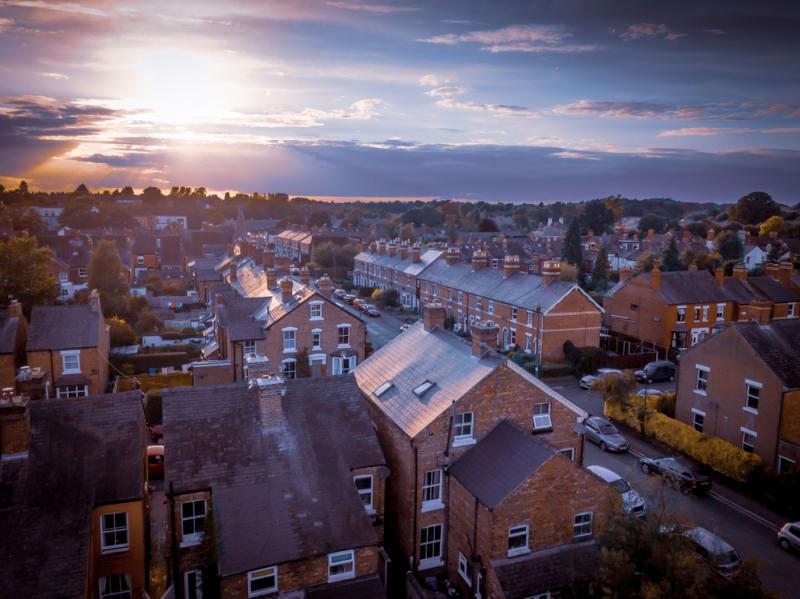
A considerable number of older people in Ireland and Northern Ireland live in housing that could pose a risk to their health. Here IPH Knowledge Translation Officer for Ageing & Public Health, Aideen Sheehan, examines available data, risk factors, and why tackling cold homes is a public health issue.
High energy bills this winter have focused attention on the difficulties of heating homes adequately. But for many older people the challenges of keeping warm go beyond the immediate worry of staying comfortably warm or paying the next heating bill – cold homes can pose a grave threat to health.
The Northern Ireland Statistics and Research Agency (NISRA) calculates that excess winter mortality accounts for almost 1,000 deaths in NI each year[1]. While COVID-19 complicates the more recent picture, data going back over the last 20 years shows that respiratory disease, circulatory disease, and dementia are the main causes of these excess winter deaths in Northern Ireland.
Central Statistics Office (CSO) data for Ireland also show higher mortality in winter months, usually peaking in January[2]. A HSE / Energy Action Ireland study indicated that there were over 8,500 excess winter deaths from all causes in the six-year period from 2007-2012 and that dementia deaths in Ireland in winter were 26% higher than in summer.[3]
Paradoxically, a study across 14 EU countries found that excess winter deaths were higher in countries with relatively mild winters but with less thermal efficient homes, such as Portugal, Spain, the UK and Ireland, whereas much colder countries, such as Scandinavia, had more heat-efficient homes, which appeared to literally insulate residents from the impact of colder climates[4].
Why are deaths so much higher in colder weather? The higher winter death rate is primarily related to the impact of cold on cardiovascular and respiratory disease factors rather than directly to hypothermia.[5]
Higher rates of cardiovascular deaths in winter, including from stroke, heart attacks, and heart failure, have been very well documented in many countries. The major causes appear to be higher blood pressure and blood becoming thicker and more likely to clot in colder temperatures.[6] Respiratory disease deaths in winter are also linked to cold air inflaming lungs and inhibiting circulation, exacerbating conditions such as asthma and chronic obstructive pulmonary disease (COPD)[7].
However, the cause of excess winter deaths from dementia is less obvious. While some of the biological reasons outlined above for higher cardiovascular mortality may be at play, additional pathways suggested for higher dementia deaths in winter have included loss of sensory perception of cold, poor eating habits and weight loss, social isolation, low levels of physical activity, being inappropriately dressed and difficulty managing heating controls or buying fuel.3
Whatever the precise mechanisms, it is clear that winter puts an added and sometimes lethal strain on older people’s health.
In a review of housing-related health issues, the World Health Organization (WHO) identified cold homes as one of the major housing problems that needs to be addressed to protect peoples’ health.7 It notes that retrofitting insulation in homes can improve health outcomes, and recommends measures to warm homes to a minimum of 18oC, and possibly more for older people and those with chronic conditions.
But cold homes are not the only element of poor housing the WHO has identified as contributing to poor health.
Other very significant factors they note include:
- Structural defects which increase the likelihood of falls.
- Poor accessibility to the house increases risk of injury, stress and isolation.
- Overcrowded housing increases the risk of exposure to infectious disease.7
How does Ireland and Northern Ireland fare with regard to housing risks, particularly in relation to older people’s homes, given the higher vulnerability of this cohort to housing-related health impacts?
Data from Northern Ireland’s House Conditions Survey 2016 (HCS) show there are 780,000 dwellings in total, though around 28,500 of these are vacant, leaving just over 751,000 occupied homes[8]. Of these 31% – around 230,000 homes – are lived in by older households where at least one person is aged 65 or over.
Further analysis of this data by IPH shows that more than half of these older person households include at least one person with a long-term limiting health condition.[9]
Around 1.7% of older peoples’ homes – approximately 4,000 – are ‘unfit’ which means they fail to meet basic standards of repair or lack facilities for being considered habitable.
Around 8.7% – approximately 20,000 are ‘non-decent’, which means they do not meet at least one of the following four criteria: meet statutory minimum standards; is not in a reasonable state of repair; is insufficiently warm; or lacks adequate modern facilities.
Furthermore 9.2% – around 21,000 homes – have a Category 1 serious health and safety hazard.[10] This includes 4.5% or 10,000 homes with a serious fall hazard and 2.3% or around 5,000 homes that are excessively cold.
The NI data further shows that 3.1% of older households (7,000) lived in homes that failed the Decent Homes thermal standard[11] and a third (33.9%) of older person households – 78,000 – were found to be in fuel poverty.[12]
Homes in Northern Ireland with cold or heating issues
| Homes in Northern Ireland with cold or heating issues | Category 1 Cold hazard | Fail thermal comfort standard | In fuel poverty (10% definition) |
| % of all households which have this issue | 1.2% | 2.7% | 21.5% |
| % of older households with this problem | 2.3% | 3.1% | 33.9% |
| No. of older households with this problem | 5,000 | 7,000 | 78,000 |
While 4% (26,000) of all NI homes were found to be overcrowded overall in the HCS survey, this was not found to be an issue in the older peoples’ homes surveyed, and practically none were found to lack adequate sanitation.
Meanwhile in Ireland there is no comparably detailed data on housing conditions currently available. However, 2016 Census data tells us there are 1.69 million occupied houses and apartments and that 396,000 of these are headed by someone aged 65 or over, with almost 8,000 of them having no central heating.[13]
The 2018 EU Survey on Income and Living Conditions (EU-SILC) also provides some information on housing conditions and problems in Ireland.
Analysis of this data tells us that 11.1% of households were headed by someone aged 65+ live in homes that had a leaking roof, damp walls, floor/foundations or rot in the window frame or door. Around 5.2% were living in homes that were considered too dark, while very small numbers (<1%) lived in homes with no bath / shower or toilet.
Environmental and security problems were also recorded – 7.7% of older households reported problems with crime, violence or vandalism in the neighbourhood, while 5.7% reported a problem with noise and 4.9% reported pollution locally.
The EU SILC data for 2018 also shows that one in seven (14.6%) older people said their housing cost was a heavy burden while 2.8% were unable to keep their home adequately warm and one in 20 reported having to go without heating because of a lack of money.
This brief examination of housing data in Ireland and Northern Ireland indicates that there are considerable numbers of older people living in housing that could pose a risk to their health, particularly with regard to keeping it sufficiently warm.
The World Health Organization has consistently called for concerted efforts from local and central governments and the health and community sectors to address housing issues that put people’s health at risk, noting that substandard housing is one of the key ways by which social inequality translates into poorer health outcomes6.
However, research by the Centre for Ageing Better in the UK also shows that improving the housing conditions of older people is not just about spending more money or providing more grants – many older people highlighted the crucial need to provide advice and support in one place, make schemes simple to use, and improve access to a pool of trusted tradespeople with the right skills to carry out improvements.[14]
COVID-19 has forced people to spend more time at home than ever before, making it even more vital that interventions to tackle cold and hazardous homes – such as the National Retrofit Scheme in Ireland[15] and the Affordable Warmth Scheme in Northern Ireland[16] – are targeted at those most vulnerable to the health impacts of poor housing and implemented in a way that makes it as easy as possible for those who will benefit most to access them.
References
[1] The five-year average of excess winter mortality in NI was 967 per year for 2014/15 to 2018/19. Excess winter mortality measures the difference between deaths in the winter months of December-March compared with non-winter deaths in adjacent periods. https://www.nisra.gov.uk/publications/excess-winter-mortality-northern-ireland-201920
[2] CSO monthly mortality data PXStat Table VSD01 available from https://www.cso.ie/en/releasesandpublications/fb/b-mpds/measuringmortalityusingpublicdatasources2019-2021/
[3] O’Farrell and Roarty (2015). Excess winter deaths in Ireland among people with Alzheimer’s disease or related dementia: lessons to be learnt. https://energyaction.ie/ea/wp-content/uploads/2017/07/Anne-OFarrell-HSE-1.pdf
[4] Healy JD (2003) Excess winter mortality in Europe: a cross country analysis identifying key risk factors. Journal of Epidemiology & Community Health 2003;57:784-78. https://jech.bmj.com/content/57/10/784
[5] Goodman, P, McAvoy H and Cotter H, (2011). Fuel Poverty, Older People and Cold Weather: An All-Island Analysis, Report. https://arrow.tudublin.ie/scschphyrep/1/
[6] Fares, A. (2013). Winter Cardiovascular Diseases Phenomenon in North American Journal of Medical Sciences. https://www.ncbi.nlm.nih.gov/pmc/articles/PMC3662093/
[7] World Health Organization (2018) WHO Housing and Health Guidelines World Health Organisation. Available online at: https://www.who.int/sustainable-development/publications/housing-health-guidelines/en/
[8] Northern Ireland Housing Executive. House Condition Survey. Main Report 2016. https://www.nihe.gov.uk/Working-With-Us/Research/House-Condition-Survey
[9] HCS 2016 data was obtained from the UK Data Service for analysis. The HCS is a detailed nationally representative survey of 2,000 homes in Northern Ireland weighted to allow estimates for the total housing stock. The figures quoted have margins of error which mean the numbers quoted are approximate rather than precise counts, particularly where the corresponding percentages are very small. The estimates of housing numbers have been rounded to the nearest thousand.
[10] Category 1 hazards are from the Health and Safety Rating System used in NI to identify defects that could pose a risk to the health and safety of residents.
[11] The Decent Homes thermal standard in the HCS asseses whether the heating system and insulation are adequate to keep the home at a comfortable termperature.
[12] A household is defined to be in fuel poverty using the official 10% definition that the cost of keeping it at a comfortable temperature would exceed 10% of household income. See HCS 2016.
[13] CSO Census 2016. Profile ! Housing in Ireland and associated Statbank tables. https://www.cso.ie/en/csolatestnews/pressreleases/2017pressreleases/pressstatementcensus2016resultsprofile1-housinginireland/.
[14] https://ageing-better.org.uk/blogs/considering-solutions-to-improve-our-homes
[15] https://www.gov.ie/en/publication/5052a-national-retrofit-plan/
[16] https://www.nihe.gov.uk/Housing-Help/Affordable-Warmth-Boiler-Replacement/Affordable-Warmth-Scheme


